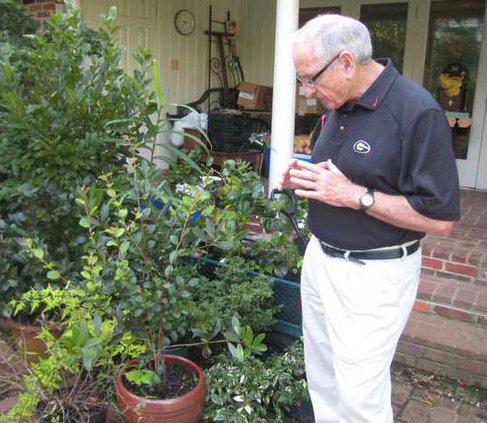‘Vince Dooley’s Garden’
Available at: Amazon.com, Books-A-Million, 150 Pearl Nix Parkway, Gainesville
ATHENS — It’s hard to get into gardening and not become passionate about it.
As soon as you find a flower in a particular shade, or a tree with specifically shaped leaves, you’ve caught the bug. Before you know it, you’re collecting specimens where you can, taking cuttings from neighbors or scouring the Internet for some specific variety of that plant you’ve fallen in love with.
But to get really inspired, visit someone else’s garden — one where their passion has allowed them to create a small-scale botanical garden. A place where plastic pots, sitting in the corner by the pool waiting to be planted, hold unique plants that you could never find at a typical garden store.
That’s what you find when you visit Vince Dooley’s garden.
“But wait,” you protest, “I can’t just drop in on the guy!”
Lucky for you, the former University of Georgia football coach and athletic director has a new book, where he’s teamed up with artist Steve Penley for a garden journal of sorts. Filled with photographs of some of Dooley’s unique plants, along with lush paintings of the garden in bloom, the book offers a look not only into Dooley’s garden but also into the journey that got him interested in horticulture to begin with.
Because, as Dooley insists, he’s one of the last people who should be writing about gardening. But a visit to his garden proves otherwise.
“All of this came out of a curiosity,” he says, surrounded by Japanese maples, various camellias and some unique potted evergreens surrounding the pool behind his home. “I was always curious about raising plants.”
While working at UGA, Dooley would audit classes — a history class here, an art class there — and eventually he worked his way into horticulture classes.
One course led to another, he said, and before long two of his professors — Michael Dirr and Allan Armitage — had him thoroughly invested in the world of plants.
“They were ornamental professors,” Dooley said. “And I guess, more than anything, that stirred my curiosity.”
His early attempts at gardening were, well, “a disaster,” he said. A vegetable garden on the hill behind the house didn’t go as planned, and a few other ornamental plants proved to be trickier than he thought.
For example, he once planted four Daphne plants under a dogwood tree near the entryway to the back yard. He’d always heard Daphne was hard to grow, but for him, they thrived.
Then, one year, the dogwood tree died.
“Within two months, they died,” he said, motioning toward the space where the plants once grew. “One thing Daphnes can’t stand is wet feet — the dogwood was absorbing all the moisture.
“So, you learn some humility in the garden.”
But overall, both the garden and the book show how Dooley grew his passion from mere curiosity into a thriving passion. He’s been across Europe to visit famous gardens, and has seen his share of horticulturists in the states, too. As he meets fellow plant lovers along the way, he gets seedlings and clippings that have taken root over the years around his sprawling yard. Some specimens were even created by Dirr or Armitage and plated in Dooley’s garden to see what happened when they grew up.
A select few have made it into a garden store near you. The ones that didn’t make the cut, though, are just as impressive.
I have to admit, I’m not much of a flower gardener. As many of you who have followed this column over the past couple of summers may have noticed, I might have an unhealthy obsession with growing tomatoes.
But after reading about Dooley’s appreciation for hydrangeas — and seeing them in person — I have a new appreciation for these ornamentals. Dooley’s garden is filled with unique varieties, and the book even offers tricks for growing them. (Tip: Cut several branches at arm’s length form the hydrangea and layer them in a 3-inch deep trench, covering them with dirt. A new hydrangea will sprout from each of the nodes.)
A chapter in the book is devoted to these plants, too, and it’s easy to fall for these plants after reading about their history. Several hydrangea crosses now sold around the country got their start in Dooley’s garden, including one called “Twist-n-Shout, a lacecap hydrangea, bred by Dirr, that blooms throughout the summer.
Dooley’s passion is infectious as he points out unique plants throughout the space — the “Dooley” camellia, a camellia crossed with an azalea, a weeping redbud. Yes even surrounded by prized specimens, he’s humble about what he’s created.
Because, when it comes down to it, gardening is a constant journey, and a constant learning process.
“If I can be a gardener, anybody can be,” he said. “But so many people can relate to it because they’re learning, and I’m continuing to learn and continuing the journey. ... It’s good for the body and good for the mind and good for the soul.”

